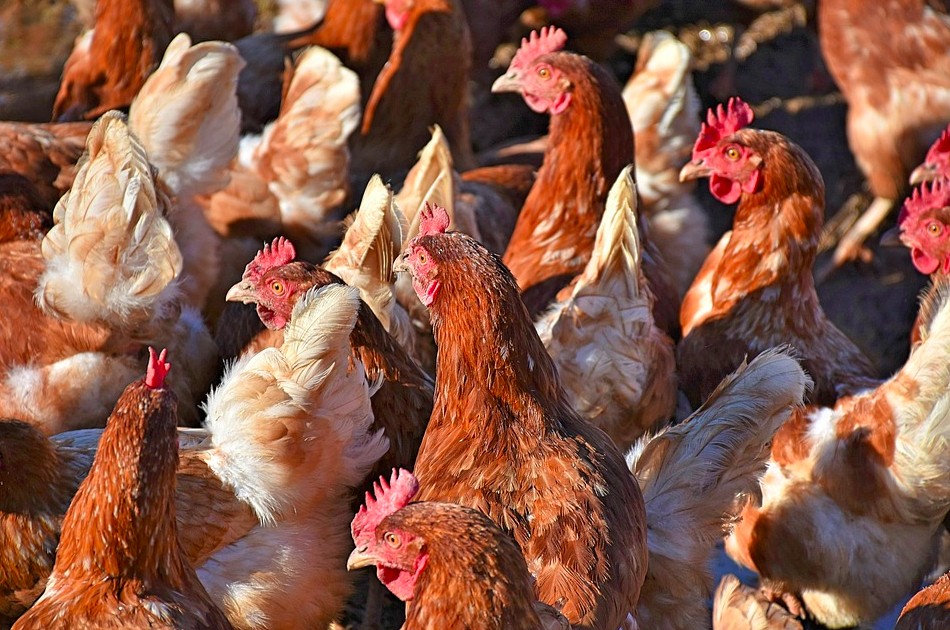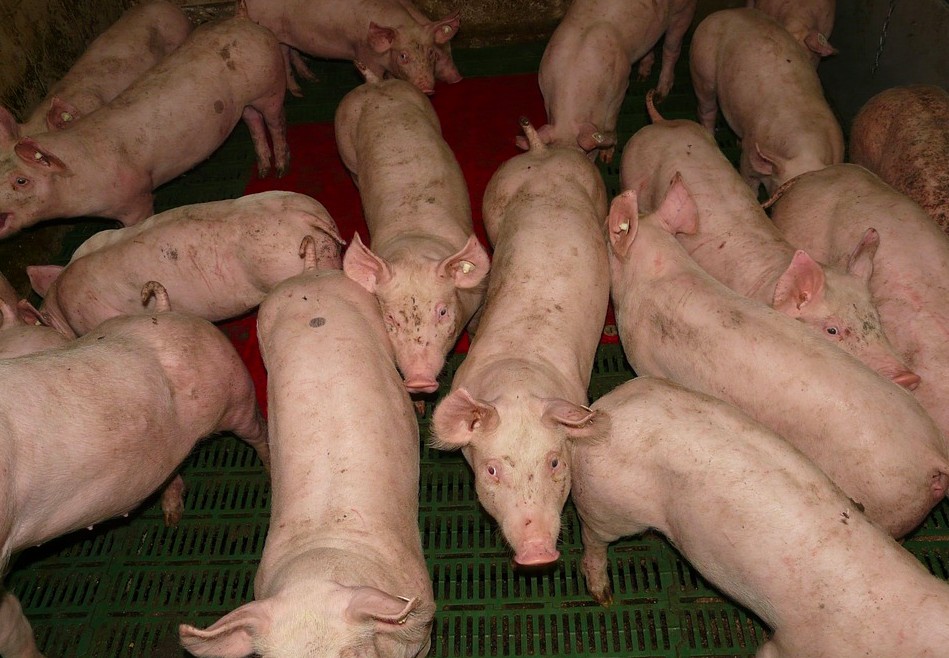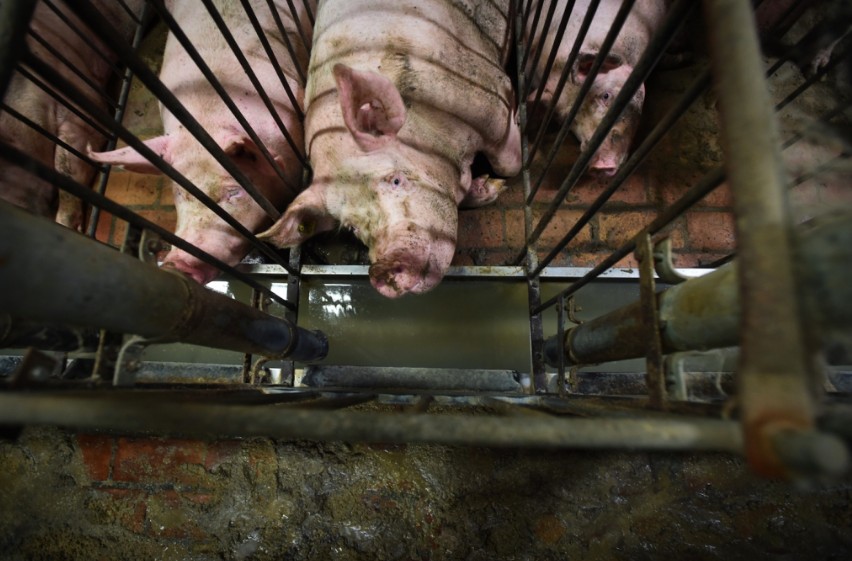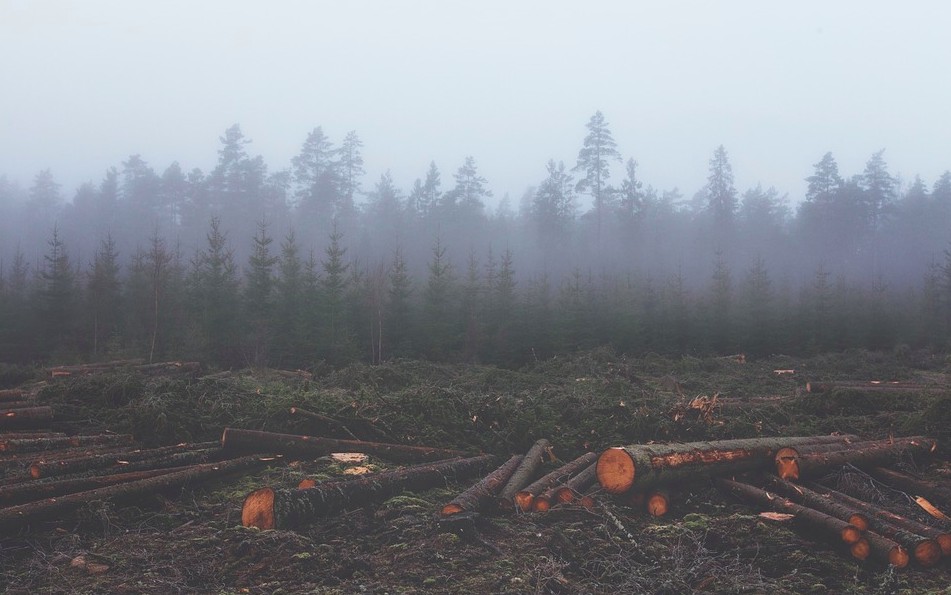What Is Beng Done About Animal Agriculture
Mill farming is the answer corporations found when the question was about turning brute agriculture into an industrial operation.
It's easy for farmers and food companies to say that factory farming is necessary to feed growing populations but that simply isn't truthful.
The reason they say that and nigh people believe information technology is actually quite obvious if yous finish to think about it.
Equally large corporations, typically multi-billion dollar multinationals buy up the competition, they're able to ready the prices wherever they desire. And because they are able to contract the dwindling number of farms to produce animal products their fashion, they accept complete control.
Industrial fauna agriculture as we know it makes it about impossible for small family unit farms to compete. In club to compete with the large factory farms, they would need to bring their prices well below what it takes them to run their modest operations. Considering of that, they need to charge more than. They might be able to get a pocket-sized group of dedicated local customers that are loyal and keep coming back just the masses will become where it's inexpensive.
And, unfortunately, mill farms produce cheap finish products.
How are they able to practice this?
By treating farm animals the same as workers care for equipment or machinery in a factory, farmers are able to enhance and produce animals at extraordinary rates. Doing so makes it final product, wearable or food in most cases, significantly cheaper for the consumer.
And while that might be practiced for business and the few people at the summit who stand to profit greatly, factory farming is bad for everything else.
Factory farming is bad for the animals. It's bad for the environment. And it's as well bad for human health. Nosotros'll comprehend some manufacturing plant farming facts in regards to all that shortly.
Before discussing some shocking factory farming facts, allow'due south first talk almost manufactory farming in full general.
What is Animal Agriculture?

Animal agriculture, or factory farming as it's normally known, is the mass industrialization of the convenance, raising, and slaughter of animals for human consumption.
The advent of industrial creature agriculture has made information technology possible for nutrient corporations to plough farms into efficient factories, past doing so, disregarding the fact that they are dealing with sentient beings and forcing them to suffer a lifetime of suffering and cruelty.
Mill farming, from a business perspective, is a brilliant way to maximize profits past dramatically increasing the supply while at the same fourth dimension bringing down production costs.
And if mill farming was dealing with the production of cotton T-shirts or toys then information technology wouldn't be as objectionable every bit it is. But the fact of the thing is that factory farming breeds animals into existence for the sole purpose of slaughter.
And to make matters worse, because the whole point of the manufacturing plant-farm goal of efficiency is to produce as many animals as possible while maximizing profits, the animals suffer the most from it.
Tens of billions of land animals per yr are born into the manufacturing plant farm system and raised in horrid atmospheric condition. They are fed unnatural diets full of antibiotics and have no room to motion about freely.
Across this, they have zilch chance of e'er knowing what it is similar to live a normal life and virtually don't ever run across the light of day.
All of this so people tin swallow food they don't need to survive.
How Animal Agriculture is Cruel to Animals
In that location are endless factory farming facts out in that location that volition make even the biggest meat eater hang their caput in shame.
And while cognitive racket is a major player when it comes to the justifications meat eaters use to eat animals while at the same time claiming to love animals, at that place are some manufactory farming statistics that volition scare just about anyone.
Let's start with chickens as they are the most slaughtered country animal in the world.
Factory Farmed Chickens
Poultry farming results in the death of tens of billions of broiler chickens every single year. And egg farming is responsible for the suffering of billions of more layer hens that are stuck in a bicycle of cruelty.
Chickens are grown on factory farms at rates well beyond what nature ever intended for them. In fact, chickens are grown three times the normal rate of that in nature causing countless wellness and physical problems.
Manufacturing plant farmed chickens have difficulty walking and holding upwardly their own body weight. Studies show that their speedily growing bodies stress their skeletons, crusade health problems, and go out them deformed.
Manufactory Farmed Cows
The dairy and beef industries also care for their cows as pegs in the machine and not living creatures.
While many people are tricked into believing that cows need to exist milked and we are simply helping with that process, the truth about the dairy industry is much more sinister.
In fact, y'all tin can contend that cows on beef farms take information technology even better than dairy cows as their suffering comes to an cease much faster.
Cows raised for beefiness are slaughtered equally babies. Almost people don't know that. A moo-cow's lifespan if she had the gamble to alive a normal life would exist between 20-25 years. A cow that is raised for beef is slaughtered between the ages of two-3 years old and a dairy cow is typically slaughtered at about 5 years one-time every bit she is no longer able to produce the high levels of milk that she shouldn't exist producing in the first identify.
Factory Farmed Pigs

Pigs are highly intelligent animals that are well enlightened of their surroundings and their relationships between family, friends, and humans.
It is believed that pigs are more intelligent than dogs and on the same level of intelligence as a three-year-old child.
Many factory farmed pigs will never see the light of 24-hour interval or feel the earth below their feet. Pigs can spend their unabridged being in concrete pens that make spinning in a circle an impossible feat.
Female pigs have it even worse. They are forced to breed continuously while going dorsum and along between gestational crates and farrowing crates. These pigs are sentenced to years of forced pregnancies and having their babies taken from them while beingness trapped on their sides in unfathomable conditions.
What Per centum of Animals Come up from Factory Farms?
In the US alone, over 95% of all animals raised to feed humans come up from factory farms.
Breaking that down, approximately viii.5 billion chickens are bred into beingness and slaughtered to feed Americans every single year. That'due south nearly 26 chickens per year for each and every American.
And if you really want to experience awful, 700 1000000 of those chickens are killed but for the Super Bowl. Americans eat approximately 1.35 billion chicken wings during Super Basin weekend.
When information technology comes to cows, the number of cows raised for beef on manufacturing plant farms is continuously going up. From 2002 to 2015, that number of cows went up by v%.
The numbers for dairy cows is even scarier. Between 1997 and 2012, the number of dairy cows in the U.s. doubled. What makes that number so outrageous is that there is a surplus of 1.39 billion pounds of cheese in the Us alone right at present. Dairy farmers are producing milk at record numbers despite the fact that Americans are drinking less and less milk. In fact, the total sales in milk in 2018 dropped by an amazing $1.1 billion.
The numbers are so alarming that the milk manufacture is fighting plant-based milk producers so they can't use the word 'milk' in their names. As the popularity of alternatives like oat milk and soy milk soar, the manufacture is taking a hit and is scared of what they're seeing.
If this trend continues, we can hope to see the number of cows being raised on dairy farms to go downwardly. Combine that with the surge in popularity of products like Beyond Burgers and Impossible Burgers and it's hard to non get excited about the potential hit that factory farming volition take.
Many people who aren't familiar with factory farms might wonder why this is a good matter. Let's get into that at present.
Is Animal Agriculture Bad?
Factory farming isn't simply bad for the animals, it'southward bad for the surround and man wellness every bit well.
While the marketing behind the meat industry might suggest otherwise, the fact of the matter is that manufacturing plant farming is cruel on many levels. Industries behind beef, dairy, eggs, and pork fight to show you a different image. They show happy cows on labels and promote the idea of humane meat, something that doesn't really be. They besides talk well-nigh costless range, muzzle free, and dozens of other terms that make you lot retrieve yous're buying ethical products when the reality is the opposite.
Mill Farming and Fauna Cruelty

Animals that are bred into existence on factory farms are never allowed the chance to alive a normal life. From the moment they are born, they are living in conditions that are unnatural in every sense of the word.
The animals are fed diets that they would never swallow in nature. They live in overcrowded weather that make mobility near impossible and the chance for diseases and illnesses to spread apace among the animals.
Factory farmers claim to care virtually their animals only what they truly care almost are their profits. That is why the animals are treated as products and not sentient beings. The farmers can argue that they exercise things to protect their animals but what they are actually doing is protecting their margins.
If they care about animals, they wouldn't breed them into existence for imminent slaughter in the kickoff place.
How Does Animal Agronomics Affect the Surround?
Study later on study after study makes information technology clear that factory farming is a major contributor to accelerated climate change. The studies keep coming out and the only people fighting back and challenge that they are incorrect are the industries behind the manufactory farms.
Every bit mentioned earlier, animals on factory farms don't consume food that they are designed by nature to consume. Cows are meant to consume grass. And while the motion picture of a cow on a green pasture on your milk box might show yous that the truth is far from that misleading prototype. On factory farms, animals are fed diets consisting of soy, corn, and grains.
Growing soy, corn, and grains for billions of animals demand a lot of land and water.
Ane report institute that 36% of the calories being produced by the earth's crops are used to feed animals on factory farms. What makes that number so shocking and infuriating is that only 12% of those calories ultimately contribute to the man diet through the beast products people swallow.
Is Fauna Agriculture the Leading Crusade of Deforestation?

The land use alone for factory farming and the deforestation that goes along with information technology paints a grim motion picture.
The country needed to be able to raise billions of animals is huge. But what is truly shocking and something almost people don't consider is the amount of land that is needed to grow the crops that feed the animals on factory farms. Livestock, both feeding and raising the animals, is ane of the leading causes of deforestation effectually the world and responsible for the devastation of 75% of the Amazon in Brazil.
All of this land could be used to produce more than enough soy, corn, grains, legumes, and vegetables for the unabridged population. Instead, the land is wasted to feed livestock and there are notwithstanding billions of people that are food insecure every single twenty-four hour period. But the nutrient industry has some of the richest executives around. Larry Pope, the CEO of Smithfield Foods, for example, makes tens of millions of dollars per year.
The people that work on the farms and slaughterhouses for Smithfield? Well, that'due south a whole nother (awful) story.
Why is Animal Agriculture Bad for Human Health?
Manufacturing plant farming isn't just bad for animals and the environment. It's bad for humans as well.
This doesn't but mean the countless factory subcontract workers that are overworked and underpaid.
Animal agronomics employees about 700,000 people. These workers are exposed to endless health hazards on the chore. From injuries sustained from machinery and the ceaseless inhalation of toxic fumes that come from cleaning chemicals, endotoxins, viruses, feces, animal dander and pare cells, animal feed, and other tiny toxins floating in the air they breathe.
But beyond the harm to the health of people working straight on the farms and the slaughterhouses, the health of the full general population suffers because of manufacturing plant farming.
For example, because and then many animals are raised on manufactory farms, the price of the meat goes down. The supply is great plenty to meet the demand and prices stay low. Because of that, a lot of the meat that comes from these farms become processed meats. There is a link between having a college gamble of certain cancers with the consumption of processed meats.
Many people in rural communities surrounding mill farms suffer profoundly from their proximity to these operations.
The aforementioned toxins that fill the air and harm the farmers spread across communities while increasing the residents' risk of respiratory problems.
And this is merely from the air they breathe. This doesn't take into account polluted water from manure runoff and chemicals used on factory farms. Information technology is the perfect toxic storm of unsafe factors that impact human being health, usually in poor rural areas where residents don't have the resources to fight back. And many of those community members are typically working on those farms likewise, making it fifty-fifty more than difficult for them to do annihilation about it.
Ending Animal Agriculture
Ending animal agronomics isn't something that will happen overnight. In fact, it volition likely take generations before nosotros are able to get rid of information technology birthday.
With that said, a lot of progress has been made in contempo years to testify the general meat-eating population that at that place are many meat alternatives out there that don't gustation anything like the bland veggie burgers from back in the mean solar day. In fact, the Across Burger and Incommunicable Burger are both exploding in popularity.
Products like these prove meat eaters that it is possible to finish eating fauna products without making desperate changes. Vegan junk food exists and more options are hitting shelves each twenty-four hours.
Clean meat will pb the way when information technology comes to catastrophe animal agriculture altogether. In the book, The End of Animal Farming, Jacy Reese outlines how the advent of new technologies backed by Silicon Valley minds and investors tin help put a cease to fauna farming by providing meat eaters with the exact aforementioned feel they are used to at the dinner table without having to swallow slaughtered animals to do it.
It's an exciting time for people that want to cease animal agriculture. Alter is happening apace and the more people are accepting these new products and ideas than most vegans would accept expected just a few years agone.
Conclusion
Beast agriculture is a disgrace.
There really is no way to sugarcoat it. Humans don't need to consume animals in club to be salubrious and survive. And nosotros certainly don't demand to treat animals like machinery or commodities.
Industrial animal agriculture is responsible for the suffering and slaughter of trillions of animals each and every yr around the globe.
It is responsible for the degradation of the environment and the acceleration of climate change.
Beyond that, animal agriculture is terrible for human being health.
While people will e'er need to eat, it's time we realize that in that location are other means to go almost it. The current way is not sustainable and information technology'south the furthest thing from ethical.
The industrial animal agriculture organization that is in place today needs to end and it needs to finish sooner rather than later. Otherwise, it will eventually exist too late.
Source: https://sentientmedia.org/animal-agriculture/
Posted by: labarberanexce2001.blogspot.com

0 Response to "What Is Beng Done About Animal Agriculture"
Post a Comment